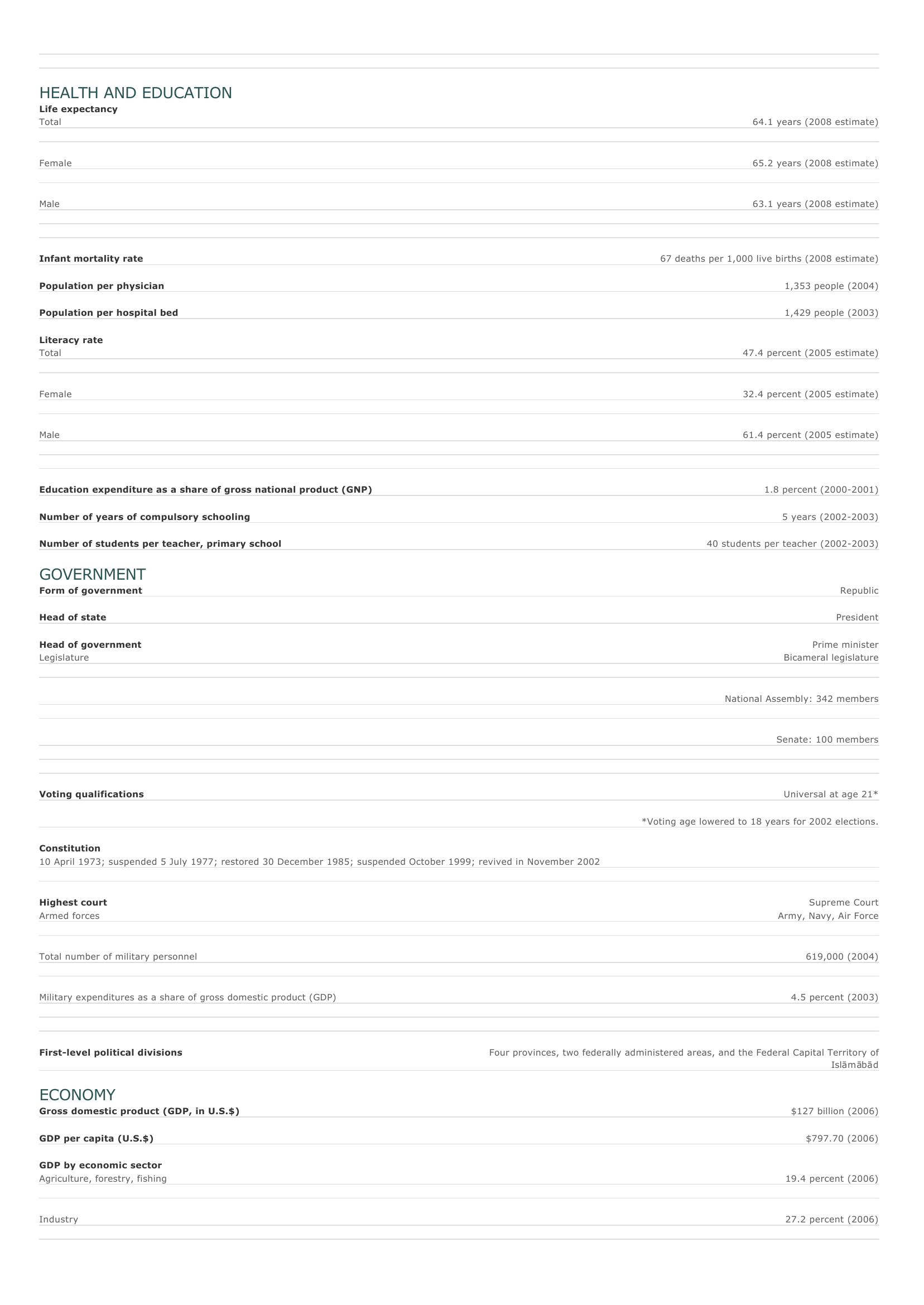
Pakistan Facts and Figures. BASIC FACTS Official name Capital Area Islamic Republic of Pakistan Isl? m ?b ? d 796,095 sq km 307,374 sq mi PEOPLE Population 167,762,040 (2008 estimate) Population growth Population growth rate 1.80 percent (2008 estimate) Projected population in 2025 218,495,756 (2025 estimate) Projected population in 2050 277,554,980 (2050 estimate) Population density 215 persons per sq km (2008 estimate) 558 persons per sq mi (2008 estimate) Urban/rural distribution Share urban 35 percent (2005 estimate) Share rural 65 percent (2005 estimate) Largest cities, with population Kar? chi Lahore 9,339,023 (2006 estimate) 5,063,499 (1998) Faisal? b ?d 2,510,000 (2007 estimate) R ?walpindi 1,406,214 (1998) Hyder? b ?d 1,390,000 (2007 estimate) Linguistic and Ethnic groups Punjabi 48 percent Pashtun 13 percent Sindhi 12 percent Saraiki 10 percent Urdu 8 percent O ther 9 percent Languages Urdu (official), English (commonly used), Punjabi, Sindhi, Pashto, Balochi, Saraiki Religious affiliations Sunni Muslim 77 percent Shia Muslim 20 percent Christian, Hindu, and other 3 percent HEALTH AND EDUCATION Life expectancy Total 64.1 years (2008 estimate) Female 65.2 years (2008 estimate) Male 63.1 years (2008 estimate) Infant mortality rate 67 deaths per 1,000 live births (2008 estimate) Population per physician 1,353 people (2004) Population per hospital bed 1,429 people (2003) Literacy rate Total 47.4 percent (2005 estimate) Female 32.4 percent (2005 estimate) Male 61.4 percent (2005 estimate) Education expenditure as a share of gross national product (GNP) 1.8 percent (2000-2001) Number of years of compulsory schooling 5 years (2002-2003) Number of students per teacher, primary school 40 students per teacher (2002-2003) GOVERNMENT Form of government Republic Head of state President Head of government Legislature Prime minister Bicameral legislature National Assembly: 342 members Senate: 100 members Voting qualifications Universal at age 21* *Voting age lowered to 18 years for 2002 elections. Constitution 10 April 1973; suspended 5 July 1977; restored 30 December 1985; suspended October 1999; revived in November 2002 Highest court Armed forces Total number of military personnel Military expenditures as a share of gross domestic product (GDP) First-level political divisions Supreme Court Army, Navy, Air Force 619,000 (2004) 4.5 percent (2003) Four provinces, two federally administered areas, and the Federal Capital Territory of Isl? m ?b ? d ECONOMY Gross domestic product (GDP, in U.S.$) GDP per capita (U.S.$) $127 billion (2006) $797.70 (2006) GDP by economic sector Agriculture, forestry, fishing 19.4 percent (2006) I ndustry 27.2 percent (2006) Services Employment Number of workers 53.4 percent (2006) 59,590,429 (2006) Workforce share of economic sector Agriculture, forestry, fishing 42 percent (2002) I ndustry 21 percent (2002) Services 37 percent (2002) Unemployment rate 7.7 percent (2004) National budget (U.S.$) Total revenue $16,947 million (2006) Total expenditure $19,285 million (2006) Monetary unit 1 Pakistani rupee (PRe), consisting of 100 paisa Agriculture Sugarcane, wheat, rice, cotton lint, corn, livestock Mining Petroleum, limestone, rock salt, gypsum, silica sand, natural gas, coal Manufacturing Textiles, food products, petroleum products, consumer goods, fertilizers, chemicals, cement Major exports Cotton clothing, thread, and textiles; raw cotton and rice; petroleum, leather, and fish products Major imports Machinery, electrical goods, petroleum products, transportation equipment, metals and metal products, fertilizer, foodstuffs Major trade partners for exports United States, United Arab Emirates, United Kingdom, Germany, and Hong Kong SAR Major trade partners for imports United Arab Emirates, Saudi Arabia, Kuwait, United States, and Japan ENERGY, COMMUNICATIONS, AND TRANSPORTATION Electricity production Electricity from thermal sources 63.70 percent (2003 estimate) Electricity from hydroelectric sources 33.94 percent (2003 estimate) Electricity from nuclear sources Electricity from geothermal, solar, and wind sources 2.35 percent (2003 estimate) 0 percent (2003 estimate) Number of radios per 1,000 people 94 (1997) Number of telephones per 1,000 people 34 (2005) Number of televisions per 1,000 people 131 (2000 estimate) Number of Internet hosts per 10,000 people 1 (2003) Daily newspaper circulation per 1,000 people 40 (1999) Number of motor vehicles per 1,000 people 14 (2004) Paved road as a share of total roads 65 percent (2004) SOURCES Basic Facts and People sections Area data are from the statistical bureaus of individual countries. Population, population growth rate, and population projections are from the United States Census Bureau, International Programs Center, International Data Base (IDB) (www.census.gov). Urban and rural population data are from the Food and Agriculture Organization (FAO) of the United Nations (UN), FAOSTAT database (www.fao.org). Largest cities population data and political divisions data are from the statistical bureaus of individual countries. Ethnic divisions and religion data are largely from the latest Central Intelligence Agency (CIA) World Factbook and from various country censuses and reports. Language data are largely from the Ethnologue, Languages of the World, Summer Institute of Linguistics International (www.sil.org). Health and Education section Life expectancy and infant mortality data are from the United States Census Bureau, International Programs Center, International database (IDB) (www.census.gov). Population per physician and population per hospital bed data are from the World Health Organization (WHO) (www.who.int). Education data are from the United Nations Educational, Scientific and Cultural Organization (UNESCO) database (www.unesco.org). Government section Government, independence, legislature, constitution, highest court, and voting qualifications data are largely from various government Web sites, the latest Europa World Yearbook, and the latest Central Intelligence Agency (CIA) World Factbook. The armed forces data is from Military Balance. Economy section Gross domestic product (GDP), GDP per capita, GDP by economic sectors, employment, and national budget data are from the World Bank database (www.worldbank.org). Monetary unit, agriculture, mining, manufacturing, exports, imports, and major trade partner information is from the statistical bureaus of individual countries, latest Europa World Yearbook, and various United Nations and International Monetary Fund (IMF) publications. Energy, Communication, and Transportation section Electricity information is from the Energy Information Administration (EIA) database (www.eia.doe.gov). Radio, telephone, television, and newspaper information is from the United Nations Educational, Scientific and Cultural Organization (UNESCO) database (www.unesco.org). Internet hosts, motor vehicles, and road data are from the World Bank database (www.worldbank.org). Note Figures may not total 100 percent due to rounding. Microsoft ® Encarta ® 2009. © 1993-2008 Microsoft Corporation. All rights reserved.








